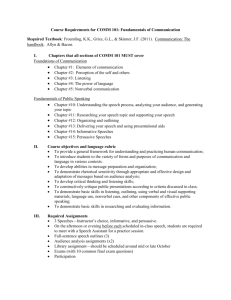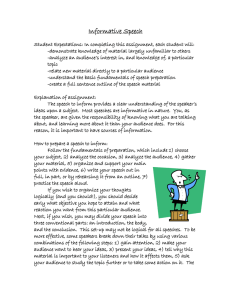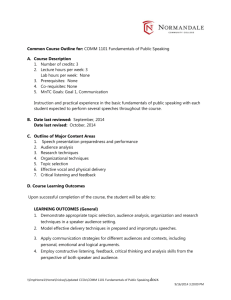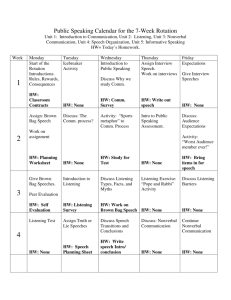HIBBING COMMUNITY COLLEGE
advertisement
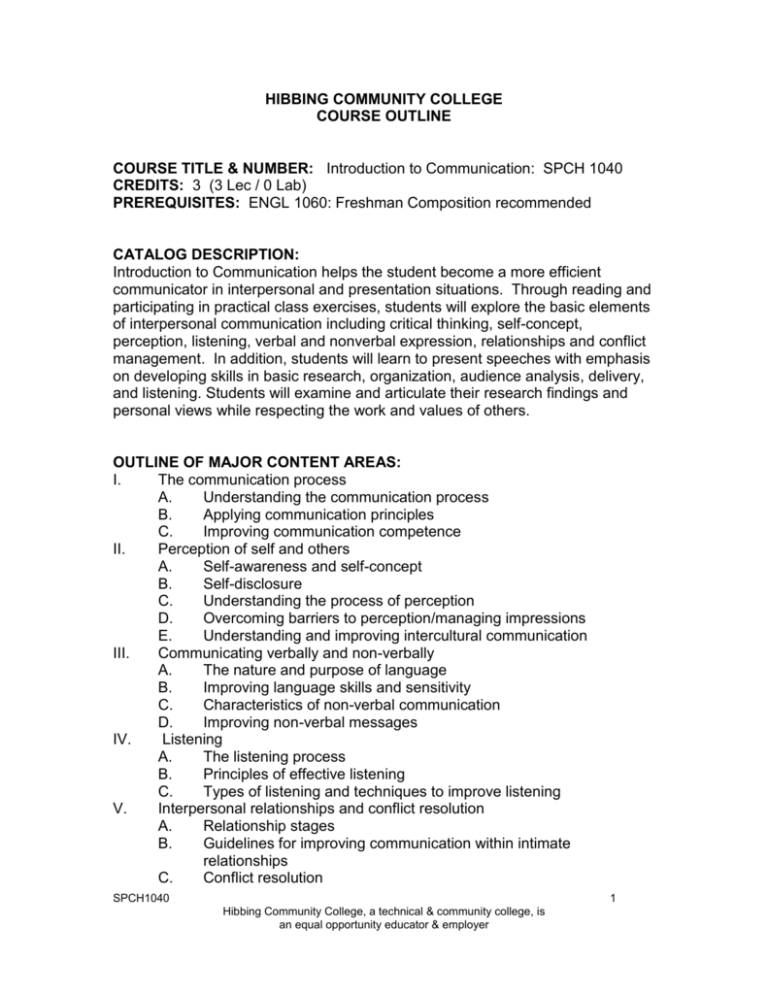
HIBBING COMMUNITY COLLEGE COURSE OUTLINE COURSE TITLE & NUMBER: Introduction to Communication: SPCH 1040 CREDITS: 3 (3 Lec / 0 Lab) PREREQUISITES: ENGL 1060: Freshman Composition recommended CATALOG DESCRIPTION: Introduction to Communication helps the student become a more efficient communicator in interpersonal and presentation situations. Through reading and participating in practical class exercises, students will explore the basic elements of interpersonal communication including critical thinking, self-concept, perception, listening, verbal and nonverbal expression, relationships and conflict management. In addition, students will learn to present speeches with emphasis on developing skills in basic research, organization, audience analysis, delivery, and listening. Students will examine and articulate their research findings and personal views while respecting the work and values of others. OUTLINE OF MAJOR CONTENT AREAS: I. The communication process A. Understanding the communication process B. Applying communication principles C. Improving communication competence II. Perception of self and others A. Self-awareness and self-concept B. Self-disclosure C. Understanding the process of perception D. Overcoming barriers to perception/managing impressions E. Understanding and improving intercultural communication III. Communicating verbally and non-verbally A. The nature and purpose of language B. Improving language skills and sensitivity C. Characteristics of non-verbal communication D. Improving non-verbal messages IV. Listening A. The listening process B. Principles of effective listening C. Types of listening and techniques to improve listening V. Interpersonal relationships and conflict resolution A. Relationship stages B. Guidelines for improving communication within intimate relationships C. Conflict resolution SPCH1040 1 Hibbing Community College, a technical & community college, is an equal opportunity educator & employer VI. VII. VIII. IX. X. XI. XII. XIII. D. Analyzing conflict management strategies Interviewing A. Understanding different of types of interviews B. Conducting effective informative interviews C. Developing strategies for employment and media interviews Small group and organizational communication A. Performing well within a team B. Understanding group dynamics C. Introduction to organizational communication concepts and problem-solving Principles of speech communication A. Public speaking as a vital means of communication B. Similarities and differences between public speaking and conversation C. Strategies for dealing with communication apprehension Topic and purpose selection for public speaking A. Steps for choosing appropriate topics for speeches B. Audience analysis C. General purpose determination for speeches D. Specific purpose determination for speeches E. Central idea selection for refining specific purpose F. Researching, evaluating and integrating sources Organization of body of speech A. Organization of ideas as a vital skill in public speaking B. Main points as most important elements in speech body C. Effective organization of supporting materials D. Organization strengthened by use of connectives E. Developing effective preparation and speaking outlines F. Effective introductions and conclusions in public speaking Speech delivery A. Effective delivery important to successful speaking B. Major characteristics of effective speech delivery C. Methods of speech delivery, including prepared and extemporaneous speeches D. Nonverbal communication and speaking Visual aids and public speaking A. Advantages of use of visual aids in speeches B. Kinds of visual aids for use in speeches C. Guidelines for effective visual aid use Types of speeches, including informative and persuasive A. Guidelines for effective informative speaking B. Principles and methods of persuasion C. Guidelines for effective persuasive speaking D. Incorporating extemporary delivery into persuasive speaking SPCH1040 2 Hibbing Community College, a technical & community college, is an equal opportunity educator & employer COURSE GOALS/OBJECTIVES/OUTCOMES: Students will: 1. demonstrate strategies for increasing perceptual accuracy. 2. demonstrate effective communication skills in group discussions. 3. identify and demonstrate examples of nonverbal communication. 4. adapt their verbal and non-verbal communication choices to fit appropriate expectations of academic, social, and work relationships. 5. identify and demonstrate effective emotional expression. 6. name and apply appropriate strategies for maintaining specific interpersonal relationships within specific contexts. 7. explain effective solutions to situations of interpersonal conflict. 8. explain the value of public speaking skills. 9. identify similarities and differences between public speaking and conversation. 10. explain why communication apprehension is normal for a public speaker and discuss methods of addressing it. 11. identify the basic elements of the speech communication process. 12. explain why a strong sense of ethical responsibility is vital for public speakers and discuss the guidelines for ethical speechmaking. 13. explain procedures to choose a speech topic and organize a speech. 14. organize, construct, and present an introductory speech. 15. construct a preparation outline. 16. construct a speaking outline. 17. explain different organizational patterns for informative speeches. 18. organize, construct, and present an informative speech. 19. explain major characteristics of effective delivery and identify methods of delivering a speech. 20. discuss nonverbal communication important to a speaker. 21. explain and use methods for practicing extemporaneous speech delivery. 22. explain advantages of using visual aids in a speech and identify types of visual aids for use in speeches. 23. use research techniques in a library to gather support materials for evidence. 24. organize, construct, and present a persuasive speech using library research materials for support. 25. explain why effective language is vital to public speaking. 26. identify methods speakers can use to make language clear. 27. identify responsibilities of group members. MNTC GOALS AND COMPETENCIES MET: Communications SPCH1040 3 Hibbing Community College, a technical & community college, is an equal opportunity educator & employer HCC CORE COMPETENCIES MET: Working Productively and Cooperatively Communicating Clearly and Effectively Thinking Creatively and Critically Social/Civic Responsibility STUDENT CONTRIBUTIONS: Students will attend class regularly, prepare and participate in class discussion, complete all assignments including speeches, impromptu speech exercises, small group discussions, and written assignments and tests. Students will be able to articulate their personal ethical views and are expected to respect the ethical views of others. Assignments completed by students must meet minimum standards set by instructor. STUDENT ASSESSMENT SHALL TAKE PLACE USING INSTRUMENTS SELECTED/DEVELOPED BY THE COURSE INSTRUCTOR. AASC APPROVAL DATE: April 20, 2011 REVIEW DATE: April 2016 SPCH1040:so 042011 SPCH1040 4 Hibbing Community College, a technical & community college, is an equal opportunity educator & employer
